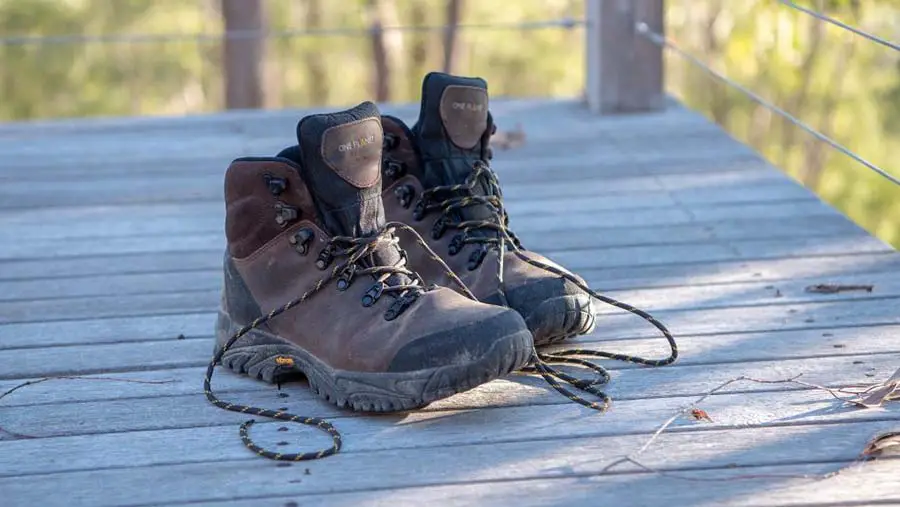ShoesandFitness.com is supported by our readers. We may earn a commission when you purchase through links on this page. Our content is checked for factual accuracy by our editorial team before being published.
Do you have a pair of new work boots and need to break them in? New boots come up with many uncomfortable issues like excruciatingly tight or pinching, heel slippage, high arches problem, etc. If they don’t fit well you could get blisters. Let’s take a look at how to break in work boots with our own tips and tricks.
So, you can break them in following the tips below. Here, I’ve discussed all the best possible ways to break-in your boots and get fit properly.
Put The Thickest Socks Inside Your Boot
If you have some thick wool socks and could still fit your foot without losing circulation, put them on inside your boot. It exaggerates the size of your foot and stretches the leather. Sometimes you might be able to remove the insole to give yourself a little bit more room inside.

Wear Them Around Your House
Wearing them, do some household stuff. If there is punching points, or hot spots or rubbing or anything like that, be mindful, if there’s heel lift, if your toes get jammed against the front, those are all signs that maybe you got the wrong size. Then if it’s possible, return them for the correct size.
Don’t Get Them Dirty
When you wear them around your house, please don’t get them dirty. You may need to return them.
Skip The Eyelets
To alleviate the High arches pressure (the top of my foot is pushing against the top of the boot), skip the eyelets and then go over the point, which is pushing into the boots. Because you don’t want those laces pressing down. You’re only supposed to be breaking in the leather, not the laces.
Use A Leather Softener
You may feel a little bit of pressure right behind your big toe, on the outside or right behind your pinky toe. Most of the time, this means that you bought a boot that’s a little bit too narrow.
Use Mink Oil or a leather softener. You can try Tendarly leather softener, it’s basically a conditioner. The conditioner or Mink Oil will help soften the leather in that area. You can apply that to wherever the stress is, and over time it will relax the leather a little bit.
Don’t Soak Your Boots With Water
For moisturizing, please use only leather conditioner, not water. It is going to create a lot more friction between wet feet and wet leather then dry feet and dry leather. It is going to be extremely uncomfortable.
Use Sand Paper
Take a little bit of 320 grit sandpaper, and sand lightly the area where your heel contacts the leather. This scuffs it up a little bit. Make it not shiny, smooth leather. So, it can grab the sock that you’re wearing and prevent your heel from slipping out.
You want to give it a little bit of grip and prevent friction. When you get friction, that’s how you get blisters. So, preventing friction is vital that’s one way to prevent your heels slipping out of the boot.
Don’t Use 80 Grit Sandpaper
You’re not going to be taking 80 grit sandpaper instead of 320 grit and sanding right through it.
Locking Your Heel Down With The Laces
One other thing that you can do to prevent heel slippage is locking your heel down with the laces. Use a surgeon’s knot and wind the two laces together a couple of times right above where your heel is on the boot. It’s going to lock your heel down and not let those laces allow any expansion.
Because you wrapped that around, there you have more friction, and it’s much more difficult for the laces to let go or transition any pressure. It’s an old hiking technique, and it works well.
Apply A Little Bit Of Heat
You can apply a little bit of heat, maybe with a hairdryer or something that’s a little bit of low heat to the areas which you feel like should stretch. Right afterward, apply a little bit of leather conditioner because you dried out that section of the leather. You also have to be careful, depending on what kind of leather it is. It could become discolored.
So, I don’t suggest putting heat on your boots unless it’s a drastic circumstance, and they need to fit right away.
Bring Your Old Pair With You
When you decide that you’re ready to venture out with your new boots, bring your old pair with you. Because if you have high arches, heel slippage, excruciatingly tight or pinching that gets uncomfortable. So, it would help if you took your other pair of boots to swap out to those, and you can continue working.

How To Break In Work Boots
You can break your new work boots in using the above methods. This will make your feet feel more comfortable and safer. Not all the methods may be equally effective in your case, some may be a little more effective and some may be a little less. So you can try all the methods one by one to see which one works best for you. Since the main task at the end of the day is to be able to break your work boots in, no matter which way it is! Whichever method you use, make sure the boots are not damaged. After breaking them in, you can use your boots safely for many years.



